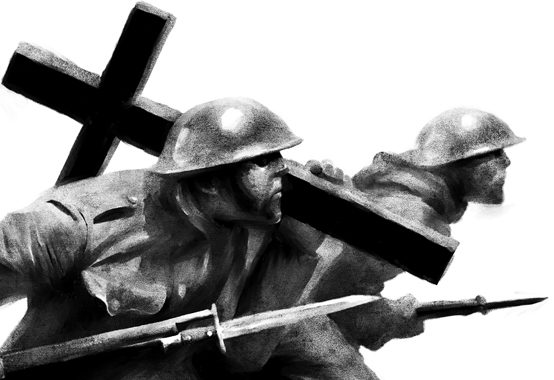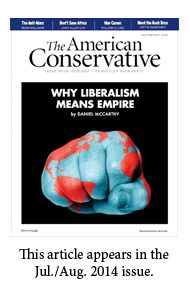Was World War I the Last Crusade?

At the end of the First World War, iconoclastic American journalist Randolph Bourne famously warned, “War is the health of the state.” He had witnessed the unprecedented expansion of national power in the heat of war mobilization. Twenty years ago, political scientist Bruce D. Porter likewise argued, “States make war, but war also makes states.” For the losers, of course, unsuccessful war destroys states, but the hundred years since the outbreak of the Great War in 1914 ought to make the symbiosis between warfare and Leviathan obvious.
Do we find similar tendencies when we turn from war and politics to war and religion? Does religion make war? In the case of the Crusades and the 16th-century wars of religion, the answer might seem obvious. But it would be hard to argue conversely that “war is the health of religion” or that “war makes the church (or the mosque).” Nevertheless, from antiquity to the present day, religion has shaped war and war has shaped religion, sometimes consciously and deliberately, sometimes with consequences evident only generations later, and always with complex twists and turns.
In The Great and Holy War, Baylor historian Philip Jenkins explores this two-way relationship in the extraordinary circumstances of World War I. Known for his sweeping global histories of Christianity, Jenkins explores the religious “mood” and motivations that, in his judgment, pervaded all sides of the Great War. Inexplicably, in the century since the war, no scholar has attempted this sort of comparative religious history of a conflict that did so much to remake Europe, her far-flung colonies, and the United States. Such neglect is unaccountable given how prominently religion appeared in the war’s rhetoric and symbolism, whether from official propaganda, belligerent clergy, or common soldiers. Jenkins’s volume comes, then, as a welcome contribution to scholarly understanding of the relationship between religion and the First World War and the consequences of that volatile mixture down to the present day.
In 448 brisk pages, Jenkins manages to cover the major Allied and Central powers, the United States, the Ottoman Empire, the emergent Middle East, Africa, India, and South Asia. He compares the experiences of Protestants, Catholics, Orthodox Christians, Jews, Muslims, and Hindus. He argues that religion entered into the motivations of the great powers as one among many causes of the war, and for Germany and Russia in particular as a driving force inseparable from those other causes. Jenkins leaves no doubt that Christianity, Judaism, and Islam contributed language, imagery, intensity, and even whole theological frameworks to the war and that adherents found their beliefs mobilized from the first shot to the last for the deadliest war the world had yet known.
Jenkins challenges conventional notions of just how secular the West had become by the early 20th century. He shows first that the generation of 1914, both at home and at the Front, carried existing religious beliefs, practices, and expectations with them. Soldiers and their families seemed to find it easy to believe rumors and press reports about the dead rising on the battlefield to fight again, prophecies, appearances of angels, and visions of Jesus himself and the Virgin Mary, such as the famous visitation at Fatima in Portugal. People routinely “biblicized” the war and invoked the aid of such Christian heroes as St. George and Joan of Arc. But “religion” did not always mean orthodox ideas and practices; it often embraced mysticism, spiritualism, the occult, and communication with the dead to find meaning in a world gone mad.
Jenkins also challenges the idea that the war itself was a profoundly secularizing experience for participants. The literature of disillusionment was vast in the 1920s and has become canonical in anthologies, but it created a false memory that either obscured how pervasive religious justifications for the war had been or else treated such expressions as cynical cover for baser material motives. If anything, Jenkins concludes, citing the recent work of historian Jonathan Ebel on the faith of American soldiers, “we should think less of disenchantment so much as re-enchantment, a renewed interest in spirituality, and a quest for certainty.” Jenkins is certainly right that standard accounts do little or nothing to prepare those curious about World War I for the widespread and persistent religious talk they will encounter in private letters and diaries, in the wartime press, in popular culture, in the visual arts, and in government publicity campaigns.
One of principal ways the belligerent powers mobilized religion was in how they defined themselves, the enemy, the stakes in the war, and what victory would bring. Jenkins shows how messianic nationalism was not only present from 1914 to 1918 but intensified through the darkest years of the war.
The Allied and Central powers depicted themselves as uniquely chosen by God to fulfill a civilizational and religious mission; demonized their enemies as Antichrist or Satan; portrayed the war as a Manichean struggle between good and evil; and promised world redemption if they and their allies triumphed, and nothing but human bondage and misery if their enemies prevailed.
Apocalypticism, encouraged by the war’s length, widening scope, and destructiveness, appeared in wartime novels and movies, animated radical political movements, and fueled end-time speculation made even more plausible among fervent premillennialists by the British army’s victory in Palestine—at biblical Armageddon, no less—and by the Balfour Declaration’s promise of a homeland for the Jews. This was a war of prophetic fulfillment.
Wartime governments found willing clergy who perpetuated holy war. Countless sermons and articles reveal just how far the clergy would go to spiritualize earthly warfare. At times they did so to support their governments, at others they did so without being asked and for no other purpose than to express their own conviction that somehow the World War really was a war of transcendent meaning. Jenkins singles out German theologians and pastors for particular censure, yet rightly concludes that overall, “as we examine the mainstream assumptions of the greatest churches at the time, we repeatedly see just how close to the surface of the Christian and biblical tradition such patterns of state alliance and militancy actually lie, and how easily ideas of the church militarist emerge in times of crisis.”
Jenkins’s most important contribution comes in the book’s second half, as he surveys what the war did to religion. Christianity, Judaism, Islam, and Hinduism all experienced upheaval. Jenkins identifies the war’s consequences as nothing short of a “global religious revolution.” To take one example, the Great War led to the final collapse and dismemberment of the Ottoman Empire.
Already known as the “sick man of Europe,” the Ottoman Empire entered the war on the side of Germany, fought desperately against the Russians, defeated the British navy in the Dardanelles and expelled British and Australian forces at Gallipoli, exacted a terrible cost on its Armenian population, but ultimately collapsed under the weight of conflict on such a scale. This war of attrition toppled the sultanate, led to the Turkish war for independence to prevent complete dismemberment by the victorious allies, and soon brought about the end of the caliphate under Ataturk’s secular republic. In the eastern Mediterranean, Islam lost its political unity under the sultan. Globally, it lost its symbolic and spiritual center in the caliphate. These dislocations sent the faithful looking for sources of renewal in their oldest traditions and scrambling for a new focal point of legitimacy and authority. Opportunists had the chance to grab for spiritual or political power in a fragmented world.
Although Jenkins does not put it in these terms, it is clear that the First World War, while in important ways a modern war of religion, was more precisely a war of civil religion. The great powers, including the United States, easily mobilized religion to wage a crusade because both church and state had been in the habit of doing so for centuries, especially since the age of romantic nationalism that swept Europe after the French Revolution. If there ever had been a united “Christendom,” by 1914 Christianity had been nationalized, instrumentalized, and divided into competing brands of civil religion. In the course of constructing the modern “secular” state, nationalism freely appropriated the language, symbolism, ritual, and dogma of Christianity.
Nationalism had become, in the postwar judgment of Carlton J.H. Hayes, “the dominant religion of the nineteenth and twentieth centuries.” It bound together peoples seeking independence from multinational empires and provided emerging states with a potent means to consolidate new nations and remake the political map of Europe.
At the same time, the older empires of Europe, whether Protestant, Catholic, or Orthodox, found the same formulas of romantic nationalism useful to resist movements for greater autonomy and to rally their peoples in a righteous cause against internal and external enemies. 
By the summer of 1914, Christianity had already been “Islamized”—in the narrow sense that it had abandoned historical and theological distinctions between church and state, religion and politics, the sacred and the secular—to such an extent that waging a global war for righteousness came effortlessly for governments, churches, soldiers, and civilians. Even sultans in Istanbul learned a thing or two from their Western neighbors about how messianic empires can mobilize religion for war and shore up a faltering regime.
The great powers may not have said it this way, but they had long since concluded that “religion is the health of the state” and that “religion makes war.”
The Great War became as terrible as it did in part because of how religion was co-opted to wage war against flesh and blood, to sustain or expand earthly kingdoms, and to legitimize ideologies of worldly redemption. A century ago, Europe turned its latest regional conflict into a world war. Four years later, four empires—Germany, Austria-Hungary, Russia, and the Ottoman Turks—lay in ruins. Religion of all kinds helped the great powers justify and wage the costliest war of attrition the world had ever seen.
Richard Gamble is the author of In Search of the City on a Hill: The Making and Unmaking of an American Myth.
Comments